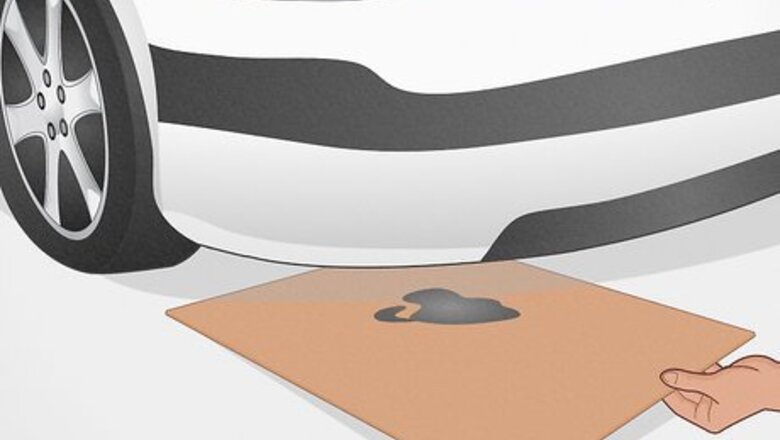
views
- For a temporary fix, pour a stop leak additive that can soften the rubber seals in your engine, which can help stop and prevent automotive oil leaks.
- If the oil pan seals are leaking, tighten the bolts along the edge of the pan. If the oil filler cap is loose, tighten or replace it.
- Visit a car mechanic to have components replaced if they’re broken. Oil pressure sensors and valve cover gaskets can be replaced for less than $300.
Identifying the Source of the Oil Leak

Place a piece of cardboard under the engine to pinpoint active leaks. To find the general area where a leak is coming from, place a large piece of cardboard under the engine block and leave it overnight. Trace the drip back up to the engine block to see what components may be causing the leak. If the puddle is red, it’s power steering or transmission fluid. If it’s yellowish-green, orange, or pastel blue, it’s antifreeze. If it’s dark brown or black, it’s engine oil. Alternatively, pour engine oil dye into your engine, let the car idle, then drive it around to allow the oil to circulate. Use a black light to look for a trail of bright, glowing oil around your engine. You can also turn on your car, sniff around the engine for burning oil, and look for blue smoke coming from the engine to get a general idea of where the leak might be coming from.
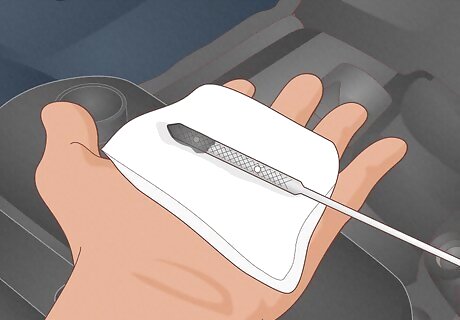
Check your engine oil levels. When your engine is cold, open the hood and pull the oil dipstick out. Wipe it off with a clean cloth, then reinsert it. Pull it out again to check your oil level. If the oil is halfway between the two marks or divots, you have enough. If your oil is overfilled, it can cause a leak. If this is the case, get a fresh oil change. If the level is low, top it up a little with a quart of oil and check the level again. Repeat until the oil is about halfway between the two marks. The dipstick is usually located near the left side of the engine and has a yellow or orange circular handle.
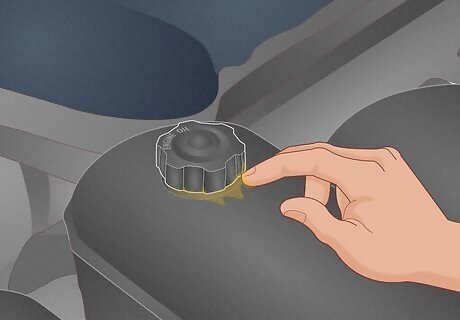
Examine the engine block components for any signs of wetness. The most common sources of an oil leak are the valve cover gaskets, oil pan seals, oil pan plug, oil pressure sensor, oil filter, oil filler cap, timing cover seal, and engine head gasket. Check your vehicle’s manual if you can’t find where these are located on your vehicle. Oil pan seals and plug: The oil pan looks like a large container underneath your engine. The plug is located on the bottom of one side of the pan. Oil pressure sensor and oil filter: The filter is a labeled metal cylinder attached to the engine block. The sensor is usually located near the filter. Oil filler cap and valve cover gaskets: The cap is on top of the engine and labeled “engine oil.” The valve cover looks like a container under the cap—check for leaks on all sides. Engine head gasket: The engine gasket is a thin piece of metal between the top of the engine (or the cylinder head) and the engine block. Timing cover seal: The timing cover is a large metal cover at the front of the engine that’s often buried under other components.
Oil Leak Causes & Solutions
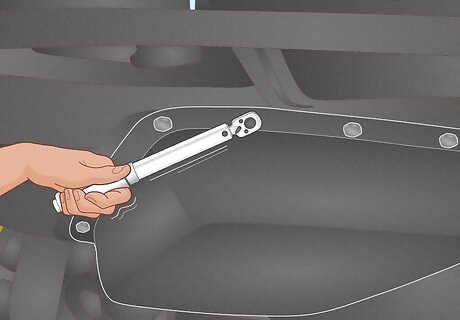
Tighten any loose bolts if the oil pan seals are leaking. Safely jack up the car. Check for loose bolts along the oil pan and tighten them with a torque wrench until the rubber gasket underneath starts to move. Tighten the two bolts in the middle, then move along the pan. After tightening one bolt, tighten the one on the opposite side. Check the dipstick to see if you need to add more oil to your car. The oil level should be halfway between the two divots or marks on your dipstick. Start the car to see if this solution solves the problem. If you still have an oil puddle, check the bolts again. Before using a jack, check your owner's manual to find the jack points on your car where the vehicle is designed to be lifted.
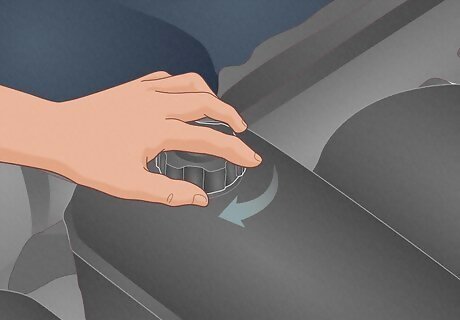
Tighten or replace the oil filler cap if it’s loose. Over time, the filler cap of the oil tank can loosen and leak. If your oil cap is loose, turn it until it’s finger-tight. If you can’t tighten the oil filler cap properly, twist the cap left to take it off completely and replace it. Most automotive parts stores can order an oil filler cap for your car’s specific make and model. An average oil filler cap costs between $5 and $15. If you’re having trouble removing the cap, consult your owner’s manual.

Try using a stop leak additive for a temporary fix. These additives can soften and reform rubber seals to stop and prevent any leaks. However, it may take up to a few hundred miles of driving before the leak is completely sealed, and it may only be temporary. Try to replace broken components before trying a stop leak additive. The best stop leak additives are: AT-205: $20 Seal Lube: $35 Justice Brothers: $22 Lubegard: $16 Blue Devil: $22

Visit a car mechanic if any components are broken. If the oil leak can’t be solved through any of the other methods, you may need to have them replaced. Visit a trusted auto mechanic to have them replace broken parts. Oil pressure sensor: Average cost is $140 and $159. Valve cover gaskets: Average cost is $240 to $289. Timing cover seal: Average cost is $500 to $3,000. This price can include $100 to $200 for parts and 18 to 20 hours of labor. Oil pan seals: Average cost is $933 to $1037. Oil pan and plug: Average cost is $956 to $1068. Oil filter: Average cost is $35 to $75. Have your oil and oil filters changed every six months or every 3,110 to 6,220 miles (5,000 to 10,000 km). Engine head gasket: Average cost is $2,000 to $4,000.
Safety

Fix any active oil leaks immediately. It’s unsafe to drive with an active oil leak. Oil leaks can lead to damage to your vehicle’s engine, radiator, and HVAC (heating and cooling) system. Oil leaks are also a safety hazard—if oil catches fire or if the engine seizes up because of excess oil, you and your other passengers could be injured. A seized engine repair, rebuild, or replacement can cost thousands of dollars.

Driving with an oil leak can also pose a major environmental hazard. Because motor oil can’t dissolve in water and is slow to degrade, it can pollute waterways. Oil and other petroleum products are also toxic to animals, plants, and humans. Avoid pouring oil or other engine fluids down storm drains, in the ground, or in ditches. Instead, drop off used motor oil for recycling at your local auto supply stores or waste collectors. Check for oil leaks regularly and place a drip pan or piece of cardboard underneath your engine to collect the oil.
Preventing Future Oil Leaks
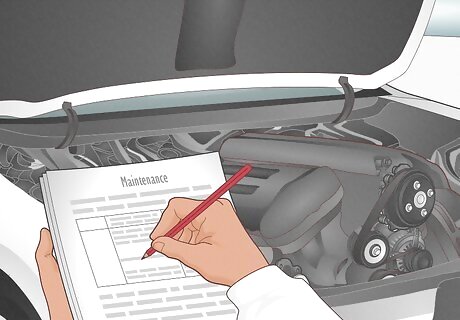
Regularly inspect your engine and perform regular maintentance. Inspect and replace any worn or damaged engine seals or gaskets as soon as possible to avoid an oil leak. Schedule regular maintenance check-ups and change your oil at a repair shop or dealership every 10,000 miles to check fluid levels, filters, and other vital components of your vehicle. Replace spark plugs, drive belts, timing belts or chains, and change air and fluid filters as needed to identify potential problems and keep the engine running well.




















Comments
0 comment